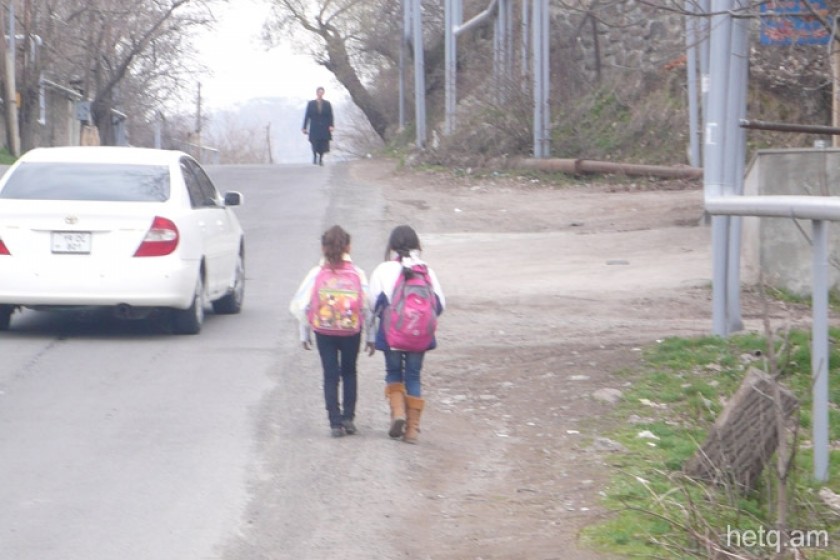
Village Has 4 Vehicles, but Garni Students Walk 6 Kilometers Every Day to School and Back
Hundreds of students living in the outer sections of Armenia’s Garni village have to walk three kilometers every day to get to school and three to return home.
It’s a dangerous trek due to the lack of a sidewalk along a major roadway full of cars and trucks.
Garni’s two schools and the one kindergarten are located in the village center. The newest school was built 43 years ago. The village has grown outwards during the past 25 years or so. Back then the walk was half of what it is today.
In 2007, a study was conducted in Garni, assessing the village’s infrastructure and schools. A panel of experts found that Garni needed a new school because students in outlying areas had to travel more than 500 meters to get to class.
Even during the Soviet period, land had been allocated for the construction of new schools in the outlying neighborhoods. Ashot Vardanyan, the mayor of Garni for the past twenty years, has placed the issue of new school construction on the backburner. He’s even sold the land.
Vardanyan has also neglected the issue of providing transportation for local students. He claims it’s not his obligation.
In years past, when parents protested and refused to send their children to school, arguing that the daily journey wasn’t safe, a vehicle was provided to transport elementary school kids.
The village municipality has four autos registered under its name. One of them belonged to Mayor Vardanyan, who sold it to the municipality for 9 million drams. He still drives it. The question arises, what are the other three vehicles used for?
When Hetq asked Mayor Vardanyan why the municipality hasn’t purchased a bus for the students he responded that it’s because his natural gas filling station closed.
“When the gas station was working, we used a bus owned by one of the villagers. We filled it at the station and he would transport the students,” said Vardanyan.
Even then, the bus wasn’t operated all the time. The driver periodically would refuse to drive students claiming that the municipality hadn’t paid him for months.
It must be noted that the municipality paid the drivers social assistance that equaled or was more than a month in salary. According to a May 2015 decision, the municipality paid Grigor Asatryan 70,000 drams. According to an April 2015 decision 100,000 drams was paid to Sergey Sahakyan.
During this school year, the bus has operated for around three months. Afterwards, school children were again forced to walk the six kilometers. Drivers plying the Yerevan-Garni route adamantly refuse to pick up the students along the way. Management at the company with the Yerevan-Garni-Geghard commuter contract claims it can no longer transport the students for free, as they had been doing, because it hinders their work. They have to ferry paying passengers.
When we asked Mayor Vardanyan why the municipality is leasing a bus when it has one of its own, he claimed that the municipality’s bus is out of service. Nevertheless, the village’s budget has, on paper, allocated 1.7 million drams for transportation expenses.
In addition, the municipality has two drivers registered on its payroll at a monthly salary of 135,000 drams.
What their duties are, remains a mystery.
In the meantime, village students still have to walk to school and back every day. Mayor Vardanyan’s excuses don’t seem to hold any water.
 Videos
Videos Photos
Photos




Write a comment